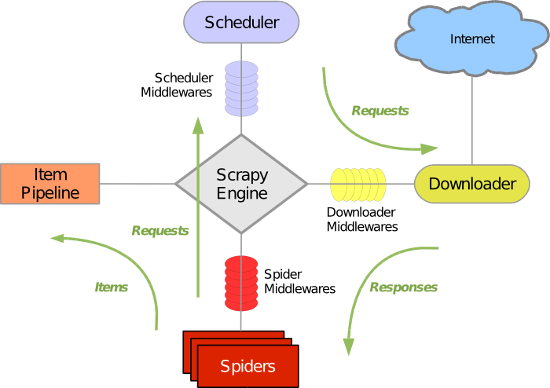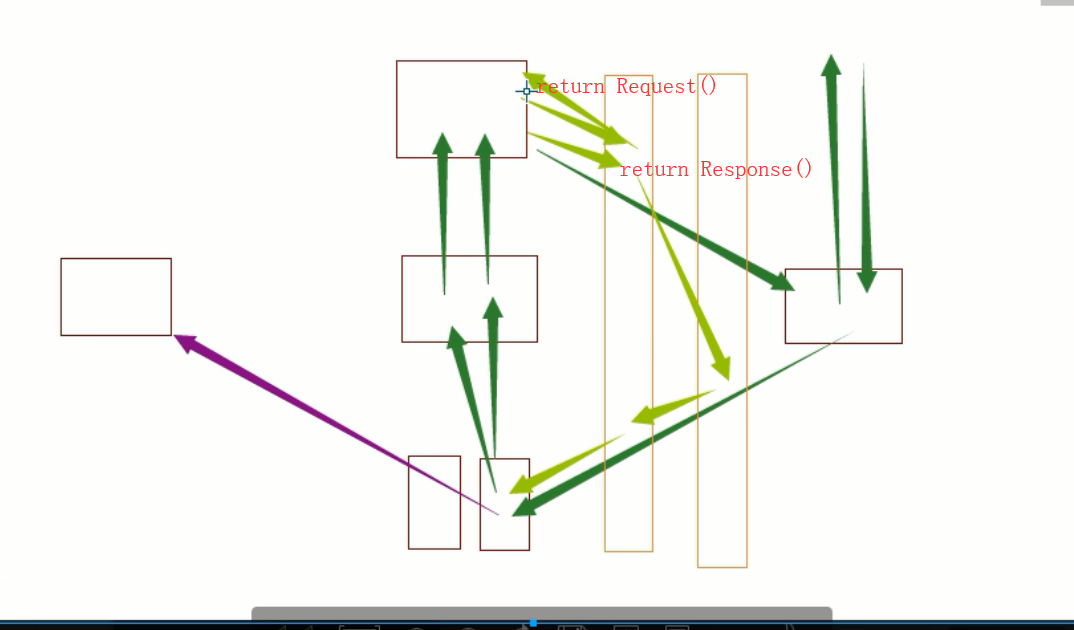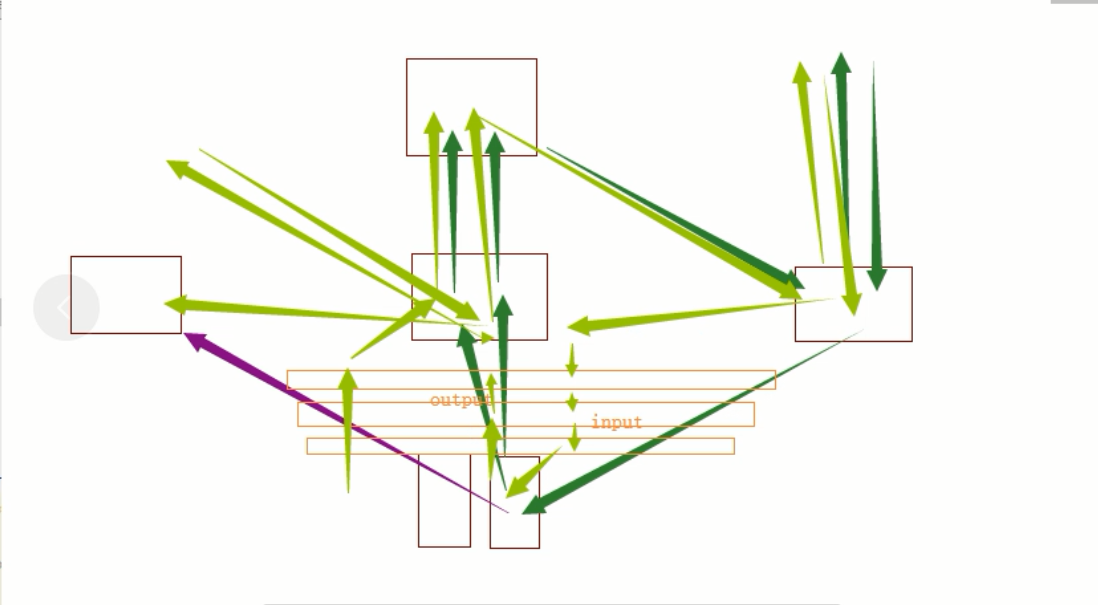Scrapy是一个为了爬取网站数据,提取结构性数据而编写的应用框架。 其可以应用在数据挖掘,信息处理或存储历史数据等一系列的程序中。
其最初是为了页面抓取 (更确切来说, 网络抓取 )所设计的, 也可以应用在获取API所返回的数据(例如 Amazon Associates Web Services ) 或者通用的网络爬虫。Scrapy用途广泛,可以用于数据挖掘、监测和自动化测试。
Scrapy 使用了 Twisted异步网络库来处理网络通讯。整体架构大致如下

Scrapy主要包括了以下组件:
- 引擎(Scrapy)
用来处理整个系统的数据流处理, 触发事务(框架核心) - 调度器(Scheduler)
用来接受引擎发过来的请求, 压入队列中, 并在引擎再次请求的时候返回. 可以想像成一个URL(抓取网页的网址或者说是链接)的优先队列, 由它来决定下一个要抓取的网址是什么, 同时去除重复的网址 - 下载器(Downloader)
用于下载网页内容, 并将网页内容返回给蜘蛛(Scrapy下载器是建立在twisted这个高效的异步模型上的) - 爬虫(Spiders)
爬虫是主要干活的, 用于从特定的网页中提取自己需要的信息, 即所谓的实体(Item)。用户也可以从中提取出链接,让Scrapy继续抓取下一个页面 - 项目管道(Pipeline)
负责处理爬虫从网页中抽取的实体,主要的功能是持久化实体、验证实体的有效性、清除不需要的信息。当页面被爬虫解析后,将被发送到项目管道,并经过几个特定的次序处理数据。 - 下载器中间件(Downloader Middlewares)
位于Scrapy引擎和下载器之间的框架,主要是处理Scrapy引擎与下载器之间的请求及响应。 - 爬虫中间件(Spider Middlewares)
介于Scrapy引擎和爬虫之间的框架,主要工作是处理蜘蛛的响应输入和请求输出。
现在的scrapy的中间件里面没有了调度中间件了。
Scrapy运行流程大概如下:
- 引擎从调度器中取出一个链接(URL)用于接下来的抓取
- 引擎把URL封装成一个请求(Request)传给下载器
- 下载器通过twisted从互联网中把资源下载下来,并封装成应答包(Response)
- 爬虫解析Response
- yield实体(Item),则交给实体管道进行持久化的处理。
- yield链接(URL),则把URL交给调度器等待抓取;相当于再一次的发送请求
一、安装
1 2 3 4 5 6 7 8 9 10 | Linux pip3 install scrapy Windows a. pip3 install wheel b. 下载twisted http://www.lfd.uci.edu/~gohlke/pythonlibs/#twisted c. 进入下载目录,执行 pip3 install Twisted‑17.1.0‑cp35‑cp35m‑win_amd64.whl d. pip3 install scrapy e. 下载并安装pywin32:https://sourceforge.net/projects/pywin32/files/ |
二、基本使用
1. 基本命令
1 2 3 4 5 6 7 8 9 10 11 12 13 14 15 16 17 | 1. scrapy startproject 项目名称 - 在当前目录中创建中创建一个项目文件(类似于Django) 2. scrapy genspider <name> <domain> - 创建爬虫应用 如: scrapy gensipider oldboy oldboy.com scrapy gensipider autohome autohome.com.cn PS: 查看所有命令:scrapy gensipider -l 查看模板命令:scrapy gensipider -d 模板名称 3. scrapy list - 展示爬虫应用列表 4. scrapy crawl 爬虫应用名称<name> - 运行单独爬虫应用 |
2.项目结构以及爬虫应用简介
1 2 3 4 5 6 7 8 9 10 11 12 | project_name/ scrapy.cfg project_name/ __init__.py items.py pipelines.py settings.py spiders/ __init__.py 爬虫1.py 爬虫2.py 爬虫3.py |
文件说明:
- scrapy.cfg 项目的主配置信息。(真正爬虫相关的配置信息在settings.py文件中)
- items.py 设置数据存储模板,用于结构化数据,如:Django的Model
- pipelines 数据处理行为,如:一般结构化的数据持久化
- settings.py 配置文件,如:递归的层数、并发数,延迟下载等
- spiders 爬虫目录,如:创建文件,编写爬虫规则
爬虫文件
1 2 3 4 5 6 7 8 9 10 11 12 13 14 15 16 17 18 19 20 21 22 23 24 25 26 27 28 29 30 31 32 33 34 35 36 37 38 39 40 41 42 43 | import scrapyfrom scrapy.http.request import Requestfrom pacong.items import PacongItemimport timeimport json# from scrapy.dupefilter import RFPDupeFilter,request_fingerprintclass ChoutiSpider(scrapy.Spider): name = 'chouti' allowed_domains = ['chouti.com'] start_urls = [ "https://dig.chouti.com/", ] # 默认scrapy遵守robot协议,所以会先请求这个文件查看自己的权限,出错是因为使用的爬虫爬取内容违背这个robot.txt。所以只要让爬虫不遵守该协议就好了, # 具体做法是找到settings文件里的ROBOTSTXT_OBEY设置成False。 # 回调函数;response响应对象 def parse(self, response): # response.meta --- > response.request.meta from scrapy.http import Response # self.request.meta print("chouti",response) # item = response.xpath('//div[@class="link-con"]') # if not item: # #点击加载更多后的数据 # ret = json.loads(response.text) # for n_news in ret["data"]: # print(n_news['title']) # print(n_news['originalUrl']) # #第一次 # data_id = item.xpath('./div/@data-id').extract() # for id in data_id: # new = response.xpath('//div[@class="link-con"]/div[@class="link-item clearfix link-item-{}"]'.format(id)) # href = new.xpath('.//a[@data-id="{}"]/@href'.format(id)).extract_first() # title = new.xpath('.//a[@data-id="{}"]/text()'.format(id)).extract_first() # print(href) # yield PacongItem(title=title, path=href) # 在spiders里面的py文件中,yield 一次 Item对象,就调用一次proces_item # yield Request()对象 就会再一次发起请求,把请求给调度器, # 然后下载器从调度器里面取任务,借助 twisted 去互联网下载网页,然后把响应返回给parse回调函数。 |
windows编码问题
1 2 | import sys,ossys.stdout=io.TextIOWrapper(sys.stdout.buffer,encoding='gb18030') |
执行此爬虫文件,则在终端进入项目目录执行如下命令:
1 | scrapy crawl chouti--nolog |
对于上述代码重要之处在于:
- Request是一个封装用户请求的类,在回调函数中yield该对象表示继续访问
- HtmlXpathSelector用于结构化HTML代码并提供选择器功能
4. 选择器
1 2 3 4 5 6 7 8 9 10 11 12 13 14 15 16 17 18 19 20 21 22 23 24 25 26 27 28 29 30 31 32 33 34 35 36 37 38 39 40 41 42 43 44 45 46 47 48 49 50 51 52 53 54 55 56 | #!/usr/bin/env python# -*- coding:utf-8 -*-from scrapy.selector import Selector, HtmlXPathSelectorfrom scrapy.http import HtmlResponsehtml = """<!DOCTYPE html><html> <head lang="en"> <meta charset="UTF-8"> <title></title> </head> <body> <ul> <li class="item-"><a id='i1' href="link.html">first item</a></li> <li class="item-0"><a id='i2' href="llink.html">first item</a></li> <li class="item-1"><a href="llink2.html">second item<span>vv</span></a></li> </ul> <div><a href="llink2.html">second item</a></div> </body></html>"""response = HtmlResponse(url='http://example.com', body=html,encoding='utf-8')# hxs = HtmlXPathSelector(response)# print(hxs)# hxs = Selector(response=response).xpath('//a')# print(hxs)# hxs = Selector(response=response).xpath('//a[2]')# print(hxs)# hxs = Selector(response=response).xpath('//a[@id]')# print(hxs)# hxs = Selector(response=response).xpath('//a[@id="i1"]')# print(hxs)# hxs = Selector(response=response).xpath('//a[@href="link.html"][@id="i1"]')# print(hxs)# hxs = Selector(response=response).xpath('//a[contains(@href, "link")]')# print(hxs)# hxs = Selector(response=response).xpath('//a[starts-with(@href, "link")]')# print(hxs)# hxs = Selector(response=response).xpath('//a[re:test(@id, "i\d+")]')# print(hxs)# hxs = Selector(response=response).xpath('//a[re:test(@id, "i\d+")]/text()').extract()# print(hxs)# hxs = Selector(response=response).xpath('//a[re:test(@id, "i\d+")]/@href').extract()# print(hxs)# hxs = Selector(response=response).xpath('/html/body/ul/li/a/@href').extract()# print(hxs)# hxs = Selector(response=response).xpath('//body/ul/li/a/@href').extract_first()# print(hxs) # ul_list = Selector(response=response).xpath('//body/ul/li')# for item in ul_list:# v = item.xpath('./a/span')# # 或# # v = item.xpath('a/span')# # 或# # v = item.xpath('*/a/span')# print(v) |
注意:settings.py中设置DEPTH_LIMIT = 1来指定“递归”的层数。
持久化 的步骤
pipeline/items
a. 先写pipeline类
class XXXPipeline(object):
def process_item(self, item, spider):
return item
b. 写Item类
class XdbItem(scrapy.Item):
href = scrapy.Field()
title = scrapy.Field()
c. 配置
ITEM_PIPELINES = {
'xdb.pipelines.XdbPipeline': 300,
}
d. 爬虫,yield每执行一次,process_item就调用一次。
yield Item对象
1 2 3 4 5 6 7 8 9 10 11 12 13 14 15 16 17 18 19 20 21 22 23 24 25 26 27 28 29 30 31 32 33 34 35 36 37 38 39 40 41 42 43 44 45 46 | class PacongPipeline(object): def __init__(self,path): self.f = None self.path = path @classmethod def from_crawler(cls,crawler): ''' 初始化的时候,用于创建 pipeline 对象 :param crawler: :return: ''' # crawler.settings 可以拿到配置文件 path = crawler.settings.get('HREF_FILE_PATH') # 返回这个类的对象的时候,就对应的执行这个类的__init__方法 return cls(path) #开始爬虫前执行的 def open_spider(self,spider): # self.f=open(self.path,'w') print("PacongPipeline",'open') #在spiders里面的py文件中,yield 一次 Item对象,就调用一次proces_item def process_item(self, item, spider): ''' :param item: 就是 PacongItem :param spider: 就是 爬虫的这个类 ChoutiSpider :return: ''' #pipeline是所有爬虫公用, #要想给特定的爬虫,就可以用spider.name来限制 # if spider.name=='chouti': # pass # print(item,type(item)) item 是一个类 # if 'http' not in item['path'] or 'https'not in item['path']: # item['path'] = 'https://dig.chouti.com' + item['path'] # # self.f.write('新闻:'+item['title']+'\n'+'链接:'+item['path']+'\n') print('PacongPipeline',item) return item #返回的 item 是交给下一个Pipeline里面的process_item方法里面的 item #结束爬虫后执行的 def close_spider(self,spider): # self.f.close() print("PacongPipeline", 'colse') |
注意:pipeline是所有爬虫公用,如果想要给某个爬虫定制需要使用spider参数自己进行处理。
去重规则
1 2 3 4 5 6 7 8 9 10 11 12 13 14 15 16 17 18 19 20 21 22 23 24 25 26 27 28 29 30 31 32 33 34 35 36 37 38 39 40 41 42 43 44 45 46 47 48 49 50 51 52 53 54 | a. 编写类 from scrapy.dupefilter import BaseDupeFilter from scrapy.utils.request import request_fingerprint class XdbDupeFilter(BaseDupeFilter): def __init__(self): self.visited_fd = set() @classmethod def from_settings(cls, settings): return cls() def request_seen(self, request): #request_fingerprint 类似将url转换为md5值; #www.123.com?k=2&n=2;n=2&k=2 优点能判断条件 是一样的 fd = request_fingerprint(request=request) if fd in self.visited_fd: return True self.visited_fd.add(fd) def open(self): # can return deferred print('开始') def close(self, reason): # can return a deferred print('结束') # def log(self, request, spider): # log that a request has been filtered # print('日志') b. 配置 # 修改默认的去重规则 # DUPEFILTER_CLASS = 'scrapy.dupefilter.RFPDupeFilter' DUPEFILTER_CLASS = 'xdb.dupefilters.XdbDupeFilter' c. 爬虫使用: class ChoutiSpider(scrapy.Spider): name = 'chouti' allowed_domains = ['chouti.com'] start_urls = ['https://dig.chouti.com/'] def parse(self, response): print(response.request.url) # item_list = response.xpath('//div[@id="content-list"]/div[@class="item"]') # for item in item_list: # text = item.xpath('.//a/text()').extract_first() # href = item.xpath('.//a/@href').extract_first() page_list = response.xpath('//div[@id="dig_lcpage"]//a/@href').extract() for page in page_list: from scrapy.http import Request page = "https://dig.chouti.com" + page yield Request(url=page,callback=self.parse,dont_filter=False) |
cookie
在发送请求时cookie的操作,
meta={'cookiejar':1}表示开启cookie记录,首次请求时写在Request()里
meta={'cookiejar':response.meta['cookiejar']}表示使用上一次response的cookie,写在FormRequest.from_response()里post授权
meta={'cookiejar':True}表示使用授权后的cookie访问需要登录查看的页面
获取Scrapy框架Cookies
请求Cookie
Cookie = response.request.headers.getlist('Cookie')
响应Cookie
Cookie2 = response.headers.getlist('Set-Cookie')
1 2 3 4 5 6 7 8 9 10 11 12 13 14 15 16 17 18 19 20 21 22 23 24 25 26 27 28 29 30 31 32 33 34 35 36 37 38 39 40 41 42 43 44 45 46 47 48 49 50 51 | # -*- coding: utf-8 -*-import scrapyfrom scrapy.http import Request,FormRequestclass PachSpider(scrapy.Spider): #定义爬虫类,必须继承scrapy.Spider name = 'pach' #设置爬虫名称 allowed_domains = ['edu.iqianyue.com'] #爬取域名 # start_urls = ['http://edu.iqianyue.com/index_user_login.html'] #爬取网址,只适于不需要登录的请求,因为没法设置cookie等信息 header = {'User-Agent':'Mozilla/5.0 (Windows NT 10.0; WOW64; rv:54.0) Gecko/20100101 Firefox/54.0'} #设置浏览器用户代理 def start_requests(self): #用start_requests()方法,代替start_urls """第一次请求一下登录页面,设置开启cookie使其得到cookie,设置回调函数""" return [Request('http://edu.iqianyue.com/index_user_login.html',meta={'cookiejar':1},callback=self.parse)] def parse(self, response): #parse回调函数 data = { #设置用户登录信息,对应抓包得到字段 'number':'adc8868', 'passwd':'279819', 'submit':'' } # 响应Cookie Cookie1 = response.headers.getlist('Set-Cookie') #查看一下响应Cookie,也就是第一次访问注册页面时后台写入浏览器的Cookie print(Cookie1) print('登录中') """第二次用表单post请求,携带Cookie、浏览器代理、用户登录信息,进行登录给Cookie授权""" return [FormRequest.from_response(response, url='http://edu.iqianyue.com/index_user_login', #真实post地址 meta={'cookiejar':response.meta['cookiejar']}, headers=self.header, formdata=data, callback=self.next, )] def next(self,response): a = response.body.decode("utf-8") #登录后可以查看一下登录响应信息 # print(a) """登录后请求需要登录才能查看的页面,如个人中心,携带授权后的Cookie请求""" yield Request('http://edu.iqianyue.com/index_user_index.html',meta={'cookiejar':True},callback=self.next2) def next2(self,response): # 请求Cookie Cookie2 = response.request.headers.getlist('Cookie') print(Cookie2) body = response.body # 获取网页内容字节类型 unicode_body = response.body_as_unicode() # 获取网站内容字符串类型 a = response.xpath('/html/head/title/text()').extract() #得到个人中心页面 print(a) |
参考https://blog.csdn.net/hoddy355/article/details/80779498
解析cookie
1 2 3 4 5 6 | cookie_jar = CookieJar() cookie_jar.extract_cookies(response, response.request) for k, v in cookie_jar._cookies.items():<br> # 去对象中将cookie解析到字典 for i, j in v.items(): for m, n in j.items(): self.cookie_dict[m] = n.value |
抽屉利用cookie点赞
1 2 3 4 5 6 7 8 9 10 11 12 13 14 15 16 17 18 19 20 21 22 23 24 25 26 27 28 29 30 31 32 33 34 35 36 37 38 39 40 41 42 43 44 45 46 47 48 49 50 51 52 53 54 55 56 57 58 59 60 61 62 63 64 65 66 67 68 69 70 71 72 73 74 75 76 77 78 79 80 81 82 83 84 85 86 | # -*- coding: utf-8 -*-import scrapyfrom scrapy.selector import HtmlXPathSelectorfrom scrapy.http.request import Requestfrom scrapy.http.cookies import CookieJarfrom scrapy import FormRequestclass ChouTiSpider(scrapy.Spider): # 爬虫应用的名称,通过此名称启动爬虫命令 name = "chouti" # 允许的域名 allowed_domains = ["chouti.com"] cookie_dict = {} has_request_set = {} def start_requests(self): url = 'http://dig.chouti.com/' # return [Request(url=url, callback=self.login)] yield Request(url=url, callback=self.login) def login(self, response): cookie_jar = CookieJar() cookie_jar.extract_cookies(response, response.request) for k, v in cookie_jar._cookies.items(): for i, j in v.items(): for m, n in j.items(): self.cookie_dict[m] = n.value req = Request( url='http://dig.chouti.com/login', method='POST', headers={'Content-Type': 'application/x-www-form-urlencoded; charset=UTF-8'}, body='phone=8615131255089&password=pppppppp&oneMonth=1', cookies=self.cookie_dict, callback=self.check_login ) yield req def check_login(self, response): req = Request( url='http://dig.chouti.com/', method='GET', callback=self.show, cookies=self.cookie_dict, dont_filter=True ) yield req def show(self, response): # print(response) hxs = HtmlXPathSelector(response) news_list = hxs.select('//div[@id="content-list"]/div[@class="item"]') for new in news_list: # temp = new.xpath('div/div[@class="part2"]/@share-linkid').extract() link_id = new.xpath('*/div[@class="part2"]/@share-linkid').extract_first() yield Request( url='http://dig.chouti.com/link/vote?linksId=%s' %(link_id,), method='POST', cookies=self.cookie_dict, callback=self.do_favor ) page_list = hxs.select('//div[@id="dig_lcpage"]//a[re:test(@href, "/all/hot/recent/\d+")]/@href').extract() for page in page_list: page_url = 'http://dig.chouti.com%s' % page import hashlib hash = hashlib.md5() hash.update(bytes(page_url,encoding='utf-8')) key = hash.hexdigest() if key in self.has_request_set: pass else: self.has_request_set[key] = page_url yield Request( url=page_url, method='GET', callback=self.show ) def do_favor(self, response): print(response.text)示例:自动登陆抽屉并点赞 |
中间件
#爬虫中间件(对深度和优先级的操作)
#下载中间件(对请求进行加工或者是加代理)
1 2 3 4 5 6 7 8 9 10 11 12 13 14 15 16 17 18 19 20 21 22 23 24 25 26 27 28 29 30 31 32 33 34 35 36 37 38 39 40 41 42 | class SpiderMiddleware(object): def process_spider_input(self,response, spider): """ 下载完成,执行,然后交给parse处理 :param response: :param spider: :return: """ pass def process_spider_output(self,response, result, spider): """ spider处理完成,返回时调用 :param response: :param result: :param spider: :return: 必须返回包含 Request 或 Item 对象的可迭代对象(iterable) """ return result def process_spider_exception(self,response, exception, spider): """ 异常调用 :param response: :param exception: :param spider: :return: None,继续交给后续中间件处理异常;含 Response 或 Item 的可迭代对象(iterable),交给调度器或pipeline """ return None def process_start_requests(self,start_requests, spider): """ 爬虫启动时调用 :param start_requests: :param spider: :return: 包含 Request 对象的可迭代对象 """ return start_requests爬虫中间件 |
1 2 3 4 5 6 7 8 9 10 11 12 13 14 15 16 17 18 19 20 21 22 23 24 25 26 27 28 29 30 31 32 33 34 35 36 37 38 39 40 41 42 43 44 | class DownMiddleware1(object): def process_request(self, request, spider): """ 请求需要被下载时,经过所有下载器中间件的process_request调用 :param request: :param spider: :return: None,继续后续中间件去下载; Response对象,停止process_request的执行,开始执行process_response Request对象,停止中间件的执行,将Request重新调度器 raise IgnoreRequest异常,停止process_request的执行,开始执行process_exception """ pass def process_response(self, request, response, spider): """ spider处理完成,返回时调用 :param response: :param result: :param spider: :return: Response 对象:转交给其他中间件process_response Request 对象:停止中间件,request会被重新调度下载 raise IgnoreRequest 异常:调用Request.errback """ print('response1') return response def process_exception(self, request, exception, spider): """ 当下载处理器(download handler)或 process_request() (下载中间件)抛出异常 :param response: :param exception: :param spider: :return: None:继续交给后续中间件处理异常; Response对象:停止后续process_exception方法 Request对象:停止中间件,request将会被重新调用下载 """ return None下载器中间件 |
下载中间件

爬虫中间件

在下载中间件加代理
1 2 3 4 5 6 7 8 9 10 11 12 13 14 15 16 17 18 19 20 21 22 23 24 25 26 27 28 29 30 31 32 33 34 35 36 37 38 39 40 41 42 43 44 45 46 47 48 49 50 51 52 53 54 55 56 57 58 59 60 61 62 63 64 65 66 67 68 69 | 下载中间件- scrapy中设置代理 - 内置 在爬虫启动时,提前在os.envrion中设置代理即可。 class ChoutiSpider(scrapy.Spider): name = 'chouti' allowed_domains = ['chouti.com'] start_urls = ['https://dig.chouti.com/'] cookie_dict = {} def start_requests(self): import os os.environ['HTTPS_PROXY'] = "http://root:woshiniba@192.168.11.11:9999/" os.environ['HTTP_PROXY'] = '19.11.2.32', for url in self.start_urls: yield Request(url=url,callback=self.parse) meta: class ChoutiSpider(scrapy.Spider): name = 'chouti' allowed_domains = ['chouti.com'] start_urls = ['https://dig.chouti.com/'] cookie_dict = {} def start_requests(self): for url in self.start_urls: yield Request(url=url,callback=self.parse,meta={'proxy':'"http://root:woshiniba@192.168.11.11:9999/"'}) - 自定义 # by luffycity.com import base64 import random from six.moves.urllib.parse import unquote try: from urllib2 import _parse_proxy except ImportError: from urllib.request import _parse_proxy from six.moves.urllib.parse import urlunparse from scrapy.utils.python import to_bytes class XdbProxyMiddleware(object): def _basic_auth_header(self, username, password): user_pass = to_bytes( '%s:%s' % (unquote(username), unquote(password)), encoding='latin-1') return base64.b64encode(user_pass).strip() #按照原码来写。 def process_request(self, request, spider): PROXIES = [ "http://root:woshiniba@192.168.11.11:9999/", "http://root:woshiniba@192.168.11.12:9999/", "http://root:woshiniba@192.168.11.13:9999/", "http://root:woshiniba@192.168.11.14:9999/", "http://root:woshiniba@192.168.11.15:9999/", "http://root:woshiniba@192.168.11.16:9999/", ] url = random.choice(PROXIES) orig_type = "" proxy_type, user, password, hostport = _parse_proxy(url) proxy_url = urlunparse((proxy_type or orig_type, hostport, '', '', '', '')) if user: creds = self._basic_auth_header(user, password) else: creds = None request.meta['proxy'] = proxy_url if creds: request.headers['Proxy-Authorization'] = b'Basic ' + creds |
自定制命令
有以下步骤:
- 在spiders同级创建任意目录,如:commands
- 在其中创建 crawlall.py 文件 (此处文件名就是自定义的命令)
-
123456789101112131415161718192021
fromscrapy.commandsimportScrapyCommandfromscrapy.utils.projectimportget_project_settingsclassCommand(ScrapyCommand):requires_project=Truedefsyntax(self):return'[options]'defshort_desc(self):return'Runs all of the spiders'defrun(self, args, opts):spider_list=self.crawler_process.spiders.list()fornameinspider_list:self.crawler_process.crawl(name,**opts.__dict__)self.crawler_process.start()crawlall.py - 在settings.py 中添加配置 COMMANDS_MODULE = '项目名称.目录名称'
- 在项目目录执行命令:scrapy crawlall
1 2 3 4 5 | import sysfrom scrapy.cmdline import executeif __name__ == '__main__': execute(["scrapy","github","--nolog"]) |
自定义扩展
自定义扩展时,利用信号在指定位置注册制定操作
用scrapy的信号,可以在爬虫前和爬虫后等定制一些操作
1 2 3 4 5 6 7 8 9 10 11 12 13 14 15 16 17 18 19 20 21 22 | from scrapy import signals#看源码可以看到所有的信号。class MyExtension(object): def __init__(self, value): self.value = value @classmethod def from_crawler(cls, crawler): val = crawler.settings.getint('MMMM') ext = cls(val) crawler.signals.connect(ext.spider_opened, signal=signals.spider_opened) crawler.signals.connect(ext.spider_closed, signal=signals.spider_closed) return ext def spider_opened(self, spider): print('open') def spider_closed(self, spider): print('close')ext = MyExtension() |
1 2 | 配置:EXTENSIONS = {'xdb.ext.MyExtend':666,} |
更多详情 点击




【推荐】还在用 ECharts 开发大屏?试试这款永久免费的开源 BI 工具!
【推荐】国内首个AI IDE,深度理解中文开发场景,立即下载体验Trae
【推荐】编程新体验,更懂你的AI,立即体验豆包MarsCode编程助手
【推荐】轻量又高性能的 SSH 工具 IShell:AI 加持,快人一步
· 软件产品开发中常见的10个问题及处理方法
· .NET 原生驾驭 AI 新基建实战系列:向量数据库的应用与畅想
· 从问题排查到源码分析:ActiveMQ消费端频繁日志刷屏的秘密
· 一次Java后端服务间歇性响应慢的问题排查记录
· dotnet 源代码生成器分析器入门
· ThreeJs-16智慧城市项目(重磅以及未来发展ai)
· .NET 原生驾驭 AI 新基建实战系列(一):向量数据库的应用与畅想
· 软件产品开发中常见的10个问题及处理方法
· Vite CVE-2025-30208 安全漏洞
· MQ 如何保证数据一致性?